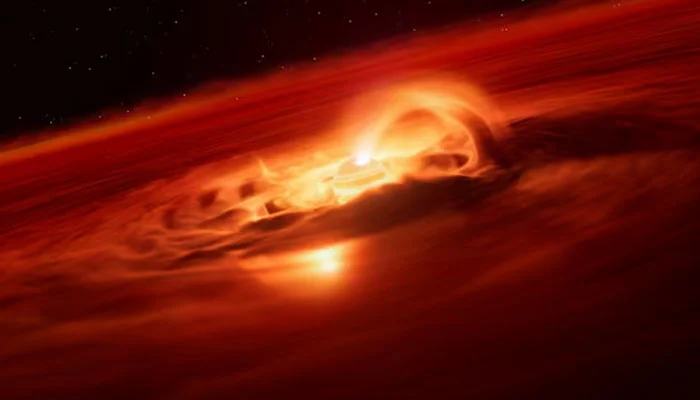Select Language:
A recent artist’s illustration depicts the planet Cha 1107-7626, situated approximately 620 light-years from Earth, released on October 2, 2025. — Reuters
Just like Earth orbits the sun, most planets discovered beyond our solar system do orbit a central star. However, some are solitary, known as rogue planets. While their origins remain largely a mystery, astronomers have now observed a young, hungry rogue planet that sheds light on these isolated worlds.
This planet, dubbed Cha 1107-7626, is estimated to be five to ten times more massive than Jupiter, the largest planet in our solar system. It was detected during an intense growth phase at the core of a disk of gas and dust, forming in a manner similar to a young star, aggressively consuming surrounding material at an unprecedented rate for an object of its kind.
In August of this year, the planet’s accretion rate peaked at about six billion tons of material per second — roughly eight times faster than just a few months prior.
“The outburst we observed is extraordinary, comparable to the most vigorous phases of star formation,” said Víctor Almendros-Abad, an astronomer at the INAF Astronomical Observatory of Palermo in Italy and the lead author of the study published this month in the Astrophysical Journal Letters. “It demonstrates that the same physical processes that promote star formation can also occur on a planetary scale.”
Almendros-Abad notes that the rogue planet is roughly one to two million years old, marking it as very young by astronomical standards. The planet appears to be nearing the end of its formation process, likely not gaining much more mass than it already has.
Scientists believe it is generating strong magnetic fields that funnel material from the surrounding disk inward, a process previously associated only with stars. The observation was made using the European Southern Observatory’s Very Large Telescope in Chile.
Located within our Milky Way galaxy, in the constellation Chamaeleon, this rogue planet is about 620 light-years from Earth. A light-year is the distance light travels in a year, approximately 5.9 trillion miles (9.5 trillion kilometers).
Rogue planets, also called free-floating planetary-mass objects, typically have a mass a few times greater than Jupiter. They drift freely through space and are not gravitationally tied to any star.
“How these objects form remains an open question,” said Belinda Damian, an astronomer at the University of St Andrews in Scotland. “They might form like stars do, through the collapse of a molecular cloud of gas and dust, or they could originate like planets within a protoplanetary disk around a young star and later get ejected from that system.”
Although Cha 1107-7626 is forming similarly to a star, it won’t reach the necessary mass to ignite hydrogen fusion at its core. Objects called brown dwarfs, which are often formed through similar processes, fall short of becoming full-fledged stars themselves. Brown dwarfs range in mass from about 13 to 81 times that of Jupiter and can briefly burn deuterium, a heavier form of hydrogen.
Studying Cha 1107-7626 may provide valuable insights into the origins of rogue planets.
“This discovery is thrilling because we usually think of planets as stable and quiet,” Damian explained. “But now we see they can be quite dynamic during their early stages, much like stars. It blurs the line between planets and stars and offers a peek into the earliest moments of rogue planet formation.”






